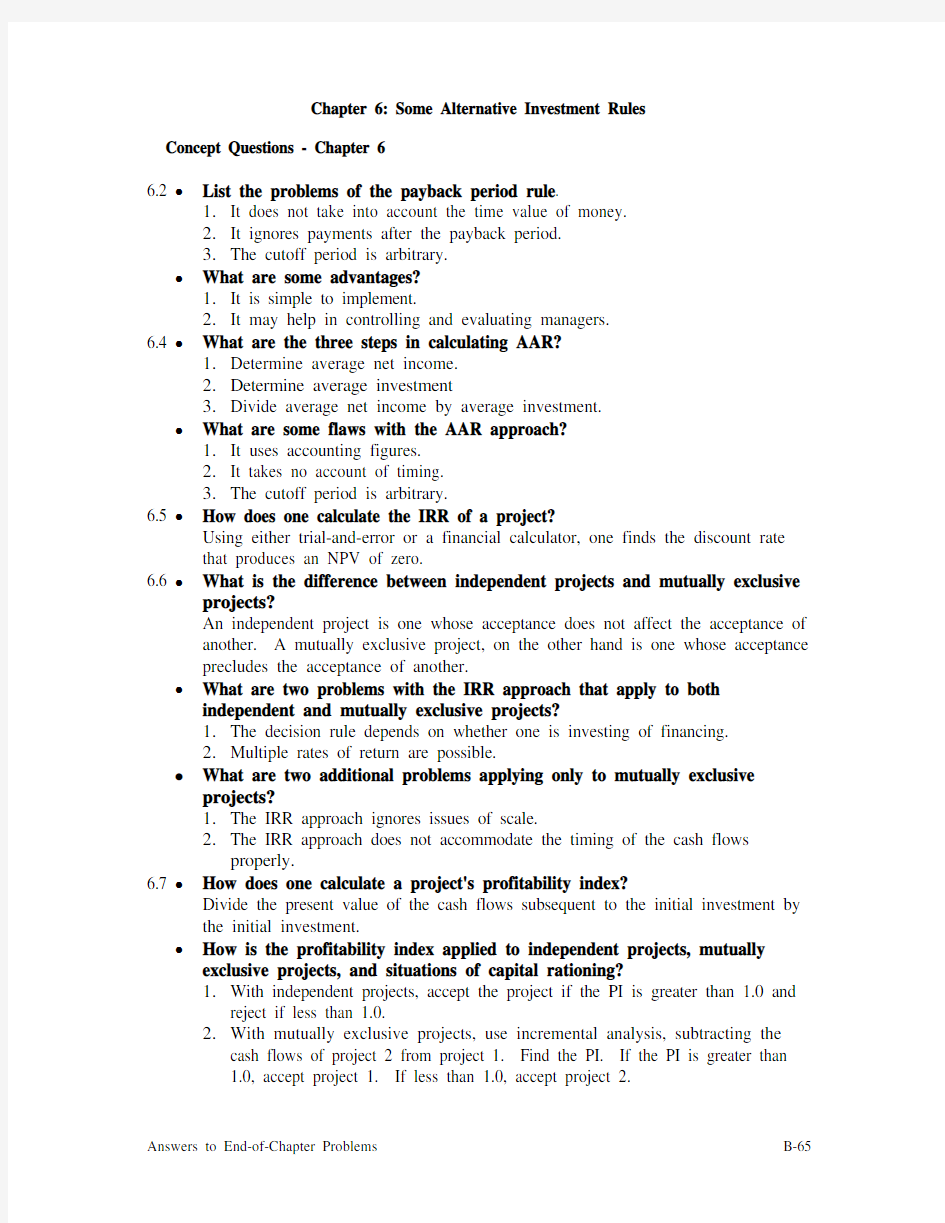
罗斯公司理财第六版习题答案第6章
- 格式:doc
- 大小:113.50 KB
- 文档页数:11


Chapter 6: Some Alternative Investment Rules
Concept Questions - Chapter 6
6.2 •List the problems of the payback period rule.
1.It does not take into account the time value of money.
2.It ignores payments after the payback period.
3.The cutoff period is arbitrary.
•What are some advantages?
1.It is simple to implement.
2.It may help in controlling and evaluating managers.
6.4 •What are the three steps in calculating AAR?
1.Determine average net income.
2.Determine average investment
3.Divide average net income by average investment.
•What are some flaws with the AAR approach?
1.It uses accounting figures.
2.It takes no account of timing.
3.The cutoff period is arbitrary.
6.5 •How does one calculate the IRR of a project?
Using either trial-and-error or a financial calculator, one finds the discount rate
that produces an NPV of zero.
6.6 •What is the difference between independent projects and mutually exclusive
projects?
An independent project is one whose acceptance does not affect the acceptance of another. A mutually exclusive project, on the other hand is one whose acceptance precludes the acceptance of another.
•What are two problems with the IRR approach that apply to both independent and mutually exclusive projects?
1.The decision rule depends on whether one is investing of financing.
2.Multiple rates of return are possible.
•What are two additional problems applying only to mutually exclusive projects?
1.The IRR approach ignores issues of scale.
2.The IRR approach does not accommodate the timing of the cash flows
properly.
6.7 •How does one calculate a project's profitability index?
Divide the present value of the cash flows subsequent to the initial investment by the initial investment.
•How is the profitability index applied to independent projects, mutually exclusive projects, and situations of capital rationing?
1.With independent projects, accept the project if the PI is greater than 1.0 and
reject if less than 1.0.
2.With mutually exclusive projects, use incremental analysis, subtracting the
cash flows of project 2 from project 1. Find the PI. If the PI is greater than
1.0, accept project 1. If less than 1.0, accept project
2.
3.In capital rationing, the firm should simply rank the projects according to their
respective PIs and accept the projects with the highest PIs, subject to the
budget constrain.
Answers to End-of-Chapter Problems
QUESTIONS AND PROBLEMS
The Payback Period Rule
6.1 Fuji Software, Inc., has the following projects.
Year Project A Project B
0 _$7,500 _$5,000
1 4,000 2,500
2 3,500 1,200
3 1,500 3,000
a. Suppose Fuji’s cutoff payback period is two years. Which of these two projects should be chosen?
b. Suppose Fuji uses the NPV rule to rank these two projects. If the appropriate discount rate is 15 percent, which project should be chosen?
6.1 a. Payback period of Project A = 1 + ($7,500 - $4,000) / $3,500 = 2 years
Payback period of Project B = 2 + ($5,000 - $2,500 -$1,200) / $3,000 = 2.43 years
Project A should be chosen.
b. NPV A = -$7,500 + $4,000 / 1.15 + $3,500 / 1.152 + $1,500 / 1.153 = -$388.96
NPV B = -$5,000 + $2,500 / 1.15 + $1,200 / 1.152 + $3,000 / 1.153 = $53.83
Project B should be chosen.
6.2 Suppose Peach Paving Company invests $1 million today on a new construction project. The project will generate annual cash flows of $150,000 in perpetuity. The appropriate annual discount rate for the project is 10 percent.
a. What is the payback period for the project? If the Peach Paving Company desires to have a 10-year payback period, should the project be adopted?
b. What is the discounted payback period for the project?
c. What is the NPV of the project?
6.2 a. Payback period = 6 + {$1,000,000 - ($150,000 ⨯ 6)} / $150,000 = 6.67 years
Yes, the project should be adopted.
A= $974,259
b. $150,000 11
.0
10
The discounted payback period = 11 + ($1,000,000 - $974,259) / ($150,000 / 1.112)
= 11.54 years
c. NPV = -$1,000,000 + $150,000 / 0.10 = $500,000
The Average Accounting Return
6.3 The annual, end-of-year, book-investment accounts for the machine whose purchase your firm is considering are shown below.
Purchase Year Year Year Year
Date 1 2 3 4
Gross investment $16,000 $16,000 $16,000 $16,000 $16,000
Less: accumulated
depreciation ______0_ ___4_,0_0_0_ ___8_,0_0_0_ __1_2_,0_0_0_ _1_6_,_0_0_0
Net investment $16,000 $12,000 $ 8,000 $ 4,000 $ 0
If your firm purchases this machine, you can expect it to generate, on average, $4,500 per
year in additional net income.
a. What is the average accounting return for this machine?
b. What three flaws are inherent in this decision rule?
6.3 a. Average Investment:
($16,000 + $12,000 + $8,000 + $4,000 + 0) / 5 = $8,000
Average accounting return:
$4,500 / $8,000 = 0.5625 = 56.25%